- Concept presentations and questions 5 dic
- Final plan presentations 13 dic
- Project working demonstrations 19 dic
Category Archives: Uncategorized
Final project assignment
The dear drawing machine is almost there..
So now the dear drawing machine is alive, watch her in action below. The darker the light the higher the resistance and thus the faster the speed of the motor. This machine is designed to be hanged on the wall to react to people passing by. If you passed by, or stand in front of it, it will start to draw according to the level of shade you project.
This is a very simple application of using a variable resistance (in this case a photoresistor (LDR)) to change voltage via PWM. Main circuit components are an Arduino UNO, LDR a 10K ohm resistor, a transistor, and a motor, and thats it. 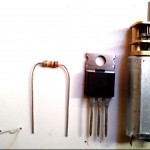
 . The variable resistance is read using AnalogRead, its value is fed into the transistor base pin via PWM pins using analogWrite, and thats it for the voltage to change according to light making a difference in motor speed. Several manipulation could be done afterwards, starting from assigning different values of light resistance sensitivity to each motor, all the way to making smart moves by designing code conditions according to serial read values from serial port. As you see, the design is simple but building the machine has some mechanical challenges starting from motor alignment to adjusting all the pieces together. I had a very successful first demo (ask Alex and the group –they witnessed
. The variable resistance is read using AnalogRead, its value is fed into the transistor base pin via PWM pins using analogWrite, and thats it for the voltage to change according to light making a difference in motor speed. Several manipulation could be done afterwards, starting from assigning different values of light resistance sensitivity to each motor, all the way to making smart moves by designing code conditions according to serial read values from serial port. As you see, the design is simple but building the machine has some mechanical challenges starting from motor alignment to adjusting all the pieces together. I had a very successful first demo (ask Alex and the group –they witnessed ![]() ) now I am providing better motor support and eliminating wiring connections, after that I should work on improving the code for smarter reactions.
) now I am providing better motor support and eliminating wiring connections, after that I should work on improving the code for smarter reactions. 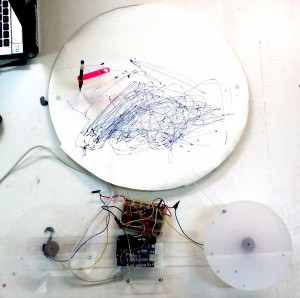
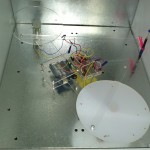
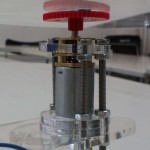
The dear drawing machine
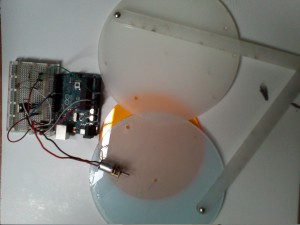 So I got an obsession with this kind of machines which come in different shapes and designs. I initially planned to build a very simple analog circuit powered by a pair of AA rechargable batteries connected to SunMod solar strip, along with a resistor, an LDR, and an LP2950 voltage regulator. The idea was to change resistance with light, so when you stand infornt of the machine and block the light it starts to draw. Then Alex advised that I use Arduino for better resistance control, so I said OK
So I got an obsession with this kind of machines which come in different shapes and designs. I initially planned to build a very simple analog circuit powered by a pair of AA rechargable batteries connected to SunMod solar strip, along with a resistor, an LDR, and an LP2950 voltage regulator. The idea was to change resistance with light, so when you stand infornt of the machine and block the light it starts to draw. Then Alex advised that I use Arduino for better resistance control, so I said OK ![]() The idea is the same but the components are slightly different, so is the protocol.
The idea is the same but the components are slightly different, so is the protocol.
In this case, we will get the value from photoresistor using AnalogRead and feed this into the transistor’s base pin via PWM and thus change speed of motor with resistance. It is working now, however, the sensitivity of the LDR doesn’t seem to correspond nicely with the motor spin, I increased the base resistor, but still..so more tweaking is needed and vamos a ver ! ![]()
//more to follow
